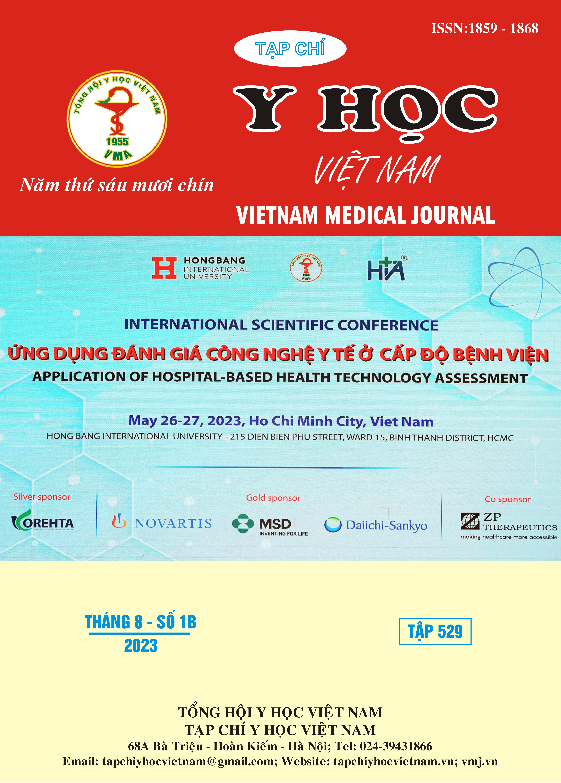CONCENTRATION STUDY TRIGLYCERID IN HDL AND SOME CORRELATIVE FACTORS IN HYPERTENSIVE PATIENTS WITH TYPE 2 DIABETES AT CAN THO CITY GENERAL HOSPITAL IN 2022-2023
Main Article Content
Abstract
Background: Hypertension and diabetes are chronic uncommunicable diseases around the world, as well as in Vietnam. The cause of these two diseases is metabolic disorder, which is most typical of blood dyslipidemia and is one of the leading mortality risks in cardiovascular disease. In Vietnam, cardiovascular disease was responsible for 31% of all deaths in 2016 - more than 170,000 people. Hypertriglyceridemia is a clinical condition associated with increased cardiovascular risk. Its impact on HDL function. In fact, HDL-T concentration has not been evaluated and is not measured in medical facilities, so we conducted a study on HDL-T concentration in hypertensive patients with type 2 diabetes. This section provides more information about this test indicator. Objective: Determination of HDL-T concentration and some correlation factors in hypertensive patients with type 2 diabetes at Can Tho City General Hospital in 2022-2023. Materials and methods: A case-control study on 168 subjects aged 40 years and older was divided into 4 groups (control groups 1: 42 people without the disease, control group 2: 42 people with hypertension, control group 3: 42 people with type 2 diabetes, group disease: 42 people hypertensive patients with type 2 diabetes). Results: HDL-T concentration in control group 1 was (0.19 ± 0.07mmol/l), control group 2 was (0.31 ± 0.13mmol/l), control group 3 was (0.25 ± 0.11mmol/l), disease group was (0.38 ± 0.17mmol/l). The correlation between HDL-T concentration in the disease group was glucose (r=0.63; p< 0.05), triglycerides (r=0.91; p<0.05), total cholesterol (r=0.21; p>0.05), HDL-C (r=-0.07; p>0.05), LDL-C (r=0.21; p>0.05). Conclusions: The concentration of HDL-T was highest in the disease group (0.38 ± 0.17 mmol/l) compared with the control group, and the difference was statistically significant (p<0.05). HDL-T concentration had a very strong positive correlation with triglycerides concentration and a moderately positive correlation with glucose concentration. HDL-T levels had no correlation with total cholesterol, HDL-C, LDL-C.
Article Details
Keywords
Hypertension, diabetes, triglycerides, HDL-T.
References
2. Trần Võ Huỳnh Nghĩa Nhân (2018), “Nghiên cứu tình hình tăng huyết áp, kiến thức và một số yếu tố liên quan đến tăng huyết áp ở người từ 40 tuổi trở lên tại xã Nhơn Nghĩa, huyện Phong Điền, thành phố Cần Thơ năm 2016”, Tập chí Y Dược học Cần Thơ, Số 11-12/2018.
3. Đào Văn Tùng (2010), Nghiên cứu nồng độ triglycerid trong HDL, nồng độ lipoprotein huyết tương ở bệnh nhân tăng huyết áp có đái tháo đường typ 2, Luận văn thạc sỹ y học, Học viện Quân Y.
4. Nguyễn Thanh Tùng (2022), “Thực trạng kiểm soát đường huyết và một số yếu tố liên quan ở người bệnh đái tháo đường tuýp 2 tại quận cái răng thành phố cần thơ năm 2021”, Tập chí Y Dược học Cần Thơ, Số 49/2022.
5. Nguyễn Lân Việt, Phạm Nguyễn Vinh, Võ Thành Nhân và cộng sự (2018), "Điều trị rối loạn lipid máu và tỷ lệ đạt cholesterol mục tiêu trên bệnh nhân bị hội chứng mạch vành cấp hoặc bệnh mạch vành ổn định tại Việt Nam - Kết quả từ Nghiên cứu DYSIS II (Dyslipidemia International Study II)", Tạp chí Tim Mạch Học Việt Nam, tr, 125-137.
6. Genest J, Libby P, (2011), "Lipoprotein disorders and cardiovascular disease", Braunwald’s Heart Disease, Chapter 47.
7. Josefa Girona, Núria Amigó, Daiana Ibarretxe et al (2019), “HDL Triglycerides: A New Marker of Metabolic and Cardiovascular Risk”, National Center of Biotechnology Information,
8. World Health Organization (2017), Cardiovascular diseases (CVDs), https://www,who,int/en/news-room/fact-sheets/detail/cardiovascular-diseases-(cvds).


